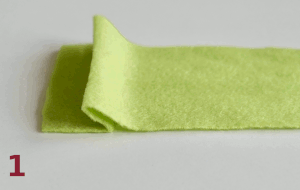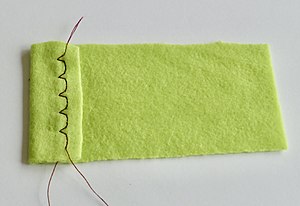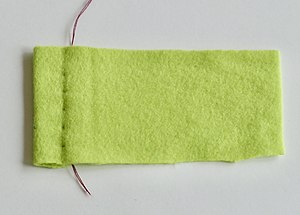Blind stitch
A blind stitch is at the transplanting or the hem employed seam . The stitch is not or almost not visible on the outside of the sewing material. It can be done by hand, especially in bespoke tailoring or skinning, or with a blind stitch machine . A fabric edge sewn with a blind stitch is called a blind hem.
The main feature of the blind stitch is that, unlike other seams, only the back of the fabric is pierced (see (1) in the drawing). The seam here is a straight stitching with regular zigzag stitches. The elastic blind stitch, on the other hand, is a zig-zig seam with regular large zig-zag stitches.
Machine blind stitch on hems
A special sewing foot is required for the seam, which has an integrated raised metal piece that allows some play in the thread and creates enough space for an accurate and even rotation of the fabric. On the adjustable rail of the blindstitch foot, the broken edge of the fabric can be aligned flush while sewing. There are also variants with a central metal guide, where the needle position has to be changed.
In the case of the hem, it is placed in such a way that the extensive zigzag stitch hits the broken edge of the fabric. After turning the fabric (see (2) in the drawing) the blind stitches are only visible at certain points. With thicker fabrics, the blind stitch can be made without piercing the outside of the material by guiding the stitch as close as possible to the breaking edge. This is particularly useful with waterproof materials such as neoprene .
In industrial use, the seam is carried out by computer-controlled single - purpose machines with a curved needle, the slim tip of which must be arranged on the outside of the arch; a ball-tipped needle could not pierce the threads. The bow needle pierces the fabric only to a predefined depth and comes out again at the top, forming a loop with the sewing thread, which is picked up by a gripper and expanded while the layers of fabric are transported on.
Individual evidence
- ↑ Alexander Tuma: Pelz-Lexikon. Fur and Rough Goods, Volume XVII . Alexander Tuma, Vienna 1949, p. 96 , keywords “blindstitch”, “blindstitch needle” .
- ^ A b Alfons Hofer: Textile and Mode Lexicon . 7th edition. 1 (A-K). Deutscher Fachverlag, Frankfurt am Main 1997, ISBN 3-87150-518-8 , keyword "Blindstich, Blindstichmaschine" .
- ↑ Instructions: Sew (almost) invisible hems with a blind stitch. Retrieved September 16, 2020 .
- ↑ Nancy Langdon: Singer: The Complete Photo Guide to Sewing, 3rd Edition . Creative Publishing international, 2017, ISBN 978-1-63159-546-2 , pp. 19 ( google.de [accessed on October 23, 2020]).
- ↑ Nicole Vasbinder: hand and machine stitches: The practical workbook for hobby tailors . Stiebner Verlag GmbH, 2014, ISBN 978-3-8307-0920-6 , p. 162 ( google.de [accessed on October 23, 2020]).
- ↑ Manfred Neitzel, Peter Mitschang, Ulf Breuer: Handbook composite materials: materials, processing, application . Carl Hanser Verlag GmbH & Company KG, 2014, ISBN 978-3-446-43697-8 , p. 112 ( google.de [accessed on October 23, 2020]).



